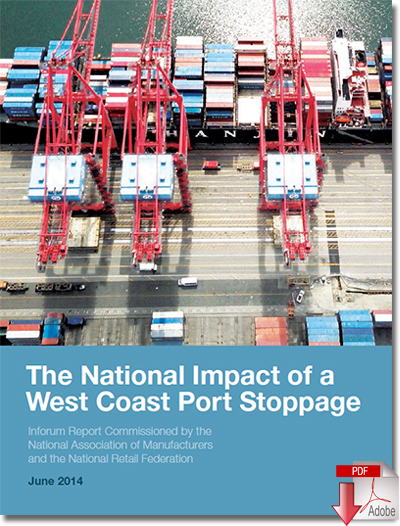Costs of Possible West Coast Port Strike are Significant, According to NAM and NRF Study
A new study shows the U.S. economy could lose as much as $2.5 billion a day if a prolonged West Coast port shutdown occurs.
As negotiations continue for a new contract agreement covering 13,600 dockworkers at 30 ports stretching from San Diego, Calif., to Bellingham, Wash., a new study shows the U.S. economy could lose as much as $2.5 billion a day if a prolonged West Coast port shutdown occurs.
The study, conducted by the National Association of Manufacturers (NAM) and the National Retail Federation (NRF) by economists at the Interindustry Forecasting Project at the University of Maryland, found that the economic repercussions of a port closure would grow with time.
As the end of June coming quickly, there still remains no new contract in place between the International Longshore Warehouse Union (ILWU) and the Pacific Maritime Association. The negotiations centers on a labor agreement for the ILWU’s roughly 14,000 West Coast port workers in California, Oregon, and Washington.
And as previously reported, the specter of a possible West Coast port labor shutdown is keeping retail shippers attentive and preparing for alternative outcomes, depending on how long it takes for the PMA and ILWU to reach an accord.
While shippers are actively working on contingency plans to get their freight into the United States, should there be a labor strike if negotiations between the PMA and ILWU break down, the economic impact of a port shutdown on the West Coast cannot be understated.
The study’s findings were quite telling, describing how the U.S. economy could lose $2.5 billion per day if a shutdown happened. It also showed how work stoppages of varying durations could negatively impact the economy as well, as:
A 5-day stoppage would:
- Reduce GDP $1.9 billion a day;
- Disrupt 73,000 jobs; and
- Cost the average household $81 in purchasing power.
A 10-day stoppage would:
- Reduce GDP $2.1 billion a day;
- Disrupt 169,000 jobs; and
- Cost the average household $170 in purchasing power.
A 20-day stoppage would:
- Reduce GDP $2.5 billion a day;
- Disrupt 405,000 jobs; and
- Cost the average household $366 in purchasing power.
If history is any type of teacher, then it clearly suggests that the PMA and ILWU would be wise to reach a deal and soon, considering that in 2002, a labor strike at West Coast ports, which handle more than two-thirds of all U.S. retail container cargo and most cargo from Asia, resulted in ports being closed for ten days and creating a backlog that took several months to be cleared and cost the U.S. economy an estimated $15 billion in reported losses.
“It is important for the parties at the table as well as others to fully understand the economic consequences of a port disruption,” NRF President and CEO Matthew Shay said in a statement. “Any supply chain disruption, whether it’s a port slowdown or outright stoppage, would cripple international trade, stymie supply chains and hurt domestic employment and consumer spending.
For retailers and their customers, a port closure would mean a delay in back-to-school and holiday shipments that could significantly drive up consumer prices.”
Shay’s comments highlight just how essential it is for shippers to be prepared in the event of a labor shutdown.
NRF Vice President of Supply Chain and Customs Policy Jon Gold said that if negotiations go longer than expected, one option for importers in terms of contingency plans is to ship early so there is sufficient inventory on hand, although it comes with additional costs to carry inventory longer than usual. Another option is shifting cargo to East and Gulf coast ports as well as Canada and Mexico, with air cargo as option for last minute orders, which is far more expensive.
“I think most larger shippers have already incurred costs for contingency planning by now, in some cases securing capacity on non-U.S. West Coast routes just in case of disruption this year,” said Paul Bingham, Economics Practice Leader, Transportation Division, CDM Smith, in a May interview. “Preparations among some shippers began many months ago knowing that negotiations this year could be challenging.
That basic step for many shippers was first to increase use of non-U.S. West Coast liner service with carriers in an attempt to assure space availability in the event of a disruption by having a preferred existing customer status. Some of the preparation has also seen shifting ordering/delivery times ahead to have buffer stocks and reduce risk of stock outs in the event of a disruption.
Other options for some shippers have been exploring source-supply shifting, in those limited instances where that is plausible in the short run, to suppliers where the supply chains that don’t depend on U.S. West Coast ports.”
Bingham also said that the planning of timing mitigation actions takes into consideration risks to sales or output, which for many retailers is tied to selling seasons, such as back-to-school or fall holiday sales. For manufacturers, he said, they may have greater ability to build buffer stocks early, while for exporters there may be less that they can do if their customers are not ready to advance their purchases.
Related: What’s Your Plan if There’s a West Coast Port Strike?















